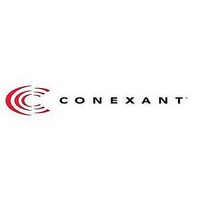bt8375kpf Conexant Systems, Inc., bt8375kpf Datasheet - Page 20

bt8375kpf
Manufacturer Part Number
bt8375kpf
Description
Single Chip Transceivers For T1/e1 And Integrated Service Digital Network Isdn Primary Rate Interfaces Systems
Manufacturer
Conexant Systems, Inc.
Datasheet
1.BT8375KPF.pdf
(323 pages)
Available stocks
Company
Part Number
Manufacturer
Quantity
Price
- Current page: 20 of 323
- Download datasheet (3Mb)
1.0 Pin Descriptions
1.1 Pin Assignments
Table 1-1. Hardware Signal Definitions (1 of 8)
1-4
RST*
MCLK
MOTO*
SYNCMD
CLKMD
A[8:0]
AD[7:0]
AS* (ALE)
CS*
DS*(RD*)
R/W*(WR*)
Pin Label
Hardware Reset
Processor Clock
Motorola Bus mode
Sync mode
Clock mode
Address Bus
Data Bus or Address
Data
Address Strobe
Chip Select
Data Strobe or
Read Strobe
Read/Write Direction
or Write Strobe
Signal Name
I
I
I
I
I
I
I/O
I
I
I
I
I/O
Microprocessor Interface (MPU)
RST* low-to-high transition forces registers to their default, power-up
AS* falling edge asynchronously latches A[8:0] (Motorola) or A[8] (Intel)
For all processor bus modes, AS* falling edge asynchronously latches
state and forces all PIO pins to the input state. RST* is not mandatory,
because internal power on reset circuit performs an identical function.
RST* can be applied asynchronously, but must remain asserted for a
minimum of 2 clock cycles (external MCLK or internal 32 MHz) for the
low-to-high transition to be sampled and detected (see also [RESET; addr
001]).
System applies MCLK in the range of 8–36 MHz for external clock
(CLKMD = 1) and synchronous bus modes (SYNCMD = 1). During internal
clock modes (CLKMD = 0), the Bt8370/8375/8376 uses an internally
generated 32 MHz clock to control processor timing, and MCLK input is
ignored.
Selects Intel- or Motorola-style microprocessor interface. DS*, R/W*,
A[8:0], and AD[7:0] functions are affected.
and R/W* indicates the read (high) or write (low) data direction.
address line, DS* is read strobe (RD*), and R/W* is write strobe (WR*).
Selects whether read/write cycle timing is synchronous with MCLK.
Supports Intel- or Motorola-style buses:
asynchronously controlled by CS*, DS*, and R/W* signals. Latched write
data is still synchronized internally to 32 MHz clock for transfer to
addressed register.
selected (CLKMD = 1). MCLK rising edge samples CS*, DS*, and R/W* to
determine valid read/write cycle timing. Allows 0 wait state processor
cycles for MCLK speeds up to 36 MHz, for M68000 type buses.
Selects whether MCLK is enabled (high) or ignored (low). When enabled,
MCLK frequency determines update rate of internal registers and sampling
rate of CS*, DS*, and R/W* signals.
to identify 1 register for subsequent read/write data transfer cycle.
Multiplexed address/data (Intel) or only data (Motorola). Refer to MOTO*
signal definition.
address from A[8:0] (Motorola) or from A[8] and AD[7:0] (Intel). For sync
modes (SYNCMD = 1), each read/write data cycle requires both AS* and
CS* active-low on MCLK rising edge.
Active-low enables read/write decoder. Active-high ends current read or
write cycle and places data bus output in high impedance.
Active-low read data strobe (RD*) for MOTO* = 1, or read/write data
strobe (DS* ) for MOTO* = 0.
Active-low write data strobe (WR*) for MOTO* = 1, or read/write data
select (R/W*) for MOTO = 0.
Conexant
0 = Motorola; AD[7:0] is data, A[8:0] is address, DS* is data strobe,
1 = Intel; AD[7:0] is multiplexed address/data, A[7:0] ignored, A[8] is
1 = Synchronous bus; applicable only if the external clock is also
0 = Asynchronous bus; read data enable and write data input latch are
Fully Integrated T1/E1 Framer and Line Interface
Definition
Bt8370/8375/8376
N8370DSE
Related parts for bt8375kpf
Image
Part Number
Description
Manufacturer
Datasheet
Request
R

Part Number:
Description:
Bluetooth RF Transceiver
Manufacturer:
Conexant Systems, Inc.
Datasheet:

Part Number:
Description:
Bluetooth RF Transceiver
Manufacturer:
Conexant Systems, Inc.
Datasheet:

Part Number:
Description:
ATM transmitter/receiver with UTOPIA interface
Manufacturer:
Conexant Systems, Inc.
Datasheet:

Part Number:
Description:
Service SAR controller
Manufacturer:
Conexant Systems, Inc.
Datasheet:

Part Number:
Description:
CN8223EPFATM Transmitter/Receiver with UTOPIA Interface
Manufacturer:
Conexant Systems, Inc.
Datasheet:

Part Number:
Description:
Embedded modem family
Manufacturer:
Conexant Systems, Inc.
Datasheet:

Part Number:
Description:
Fully integrated T1/E1 framer and line interface
Manufacturer:
Conexant Systems, Inc.
Datasheet:

Part Number:
Description:
Flicker-free video encoder
Manufacturer:
Conexant Systems, Inc.
Datasheet:

Part Number:
Description:
Home Networking Physical Layer Device with Integrated Analog Front End Circuitry Data Sheet (Preliminary) CX82100-41Home Network Processor (HNP)
Manufacturer:
Conexant Systems, Inc.
Datasheet:

Part Number:
Description:
Manufacturer:
Conexant Systems, Inc.
Datasheet:

Part Number:
Description:
Manufacturer:
Conexant Systems, Inc.
Datasheet:

Part Number:
Description:
Manufacturer:
Conexant Systems, Inc.
Datasheet:

Part Number:
Description:
Flicker-free video encoder
Manufacturer:
Conexant Systems, Inc.
Datasheet:

Part Number:
Description:
SmartV.XX Modem
Manufacturer:
Conexant Systems, Inc.
Datasheet:

Part Number:
Description:
Multichannel synchronous communications controller
Manufacturer:
Conexant Systems, Inc.
Datasheet:











